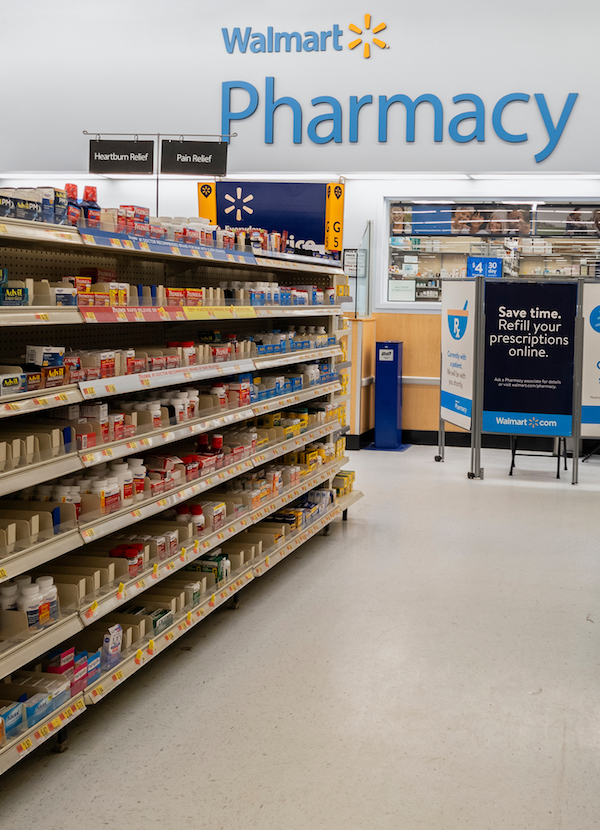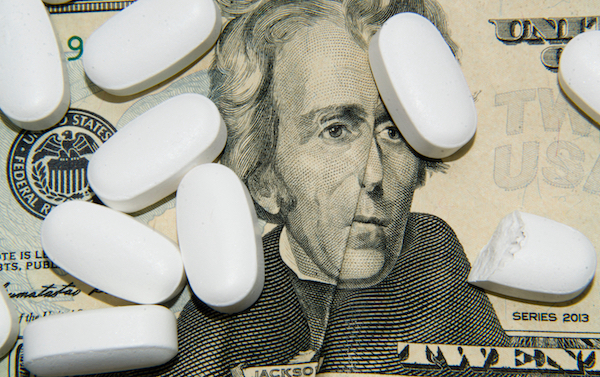Prescription giants like Walmart, Walgreens and CVS are trying to defend their practices in federal court in Cleveland
By Mark Mravic
Now it’s the pharmacies’ turn in the crosshairs.
Over the past decade, the triad of business interests at the heart of the opioid epidemic—drug manufacturers, distributors and dispensers—has come under a barrage of lawsuits for its role in creating and propagating the addiction epidemic that has cost more than half a million American lives. And in the past few years, a spate of legal action has brought the first two parts of that triad at least in part to heel.
Through a series of suits and settlements, Purdue Pharmaceuticals, makers of OxyContin, agreed to pay $4.5 billion toward opioid abatement and was dissolved. (Though to the dismay of many observers, members of the Sackler family that own Purdue appear to have escaped criminal penalty.) And in a settlement over the summer involving the second part of the triad, distributors McKesson, Amerisource Bergen and Cardinal Health agreed to pony up nearly $20 billion to settle multidistrict litigation (MDL) involving thousands of plaintiffs. (Manufacturer Johnson & Johnson also agreed to a multibillion settlement in that case.) A federal bench trial in West Virginia pitting several hard-hit communities against the Big Three distributors is awaiting a verdict.
The shape of these opioid trials is becoming familiar. In this case, Lake and Trumbull [counties] have submitted data showing that between 2012 and 2016, pharmacies in the two counties dispensed 141 million opioid pills, amounting to 265 for every resident of Lake and 400 for every person in Trumbull.”
So what about the third leg of the triad, the drugstores that dispensed the millions of opioids that flooded American cities and towns?
Earlier this month, a bellwether trial kicked off in federal district court in Cleveland in which two Ohio counties, Lake and Trumbull, are suing pharmacy giants Walmart, Walgreens and CVS, as well as regional chain Giant Eagle. (Rite-Aid, another party to the suit, settled over the summer.) The counties claim the companies were criminally lax in their oversight of the way opioid prescriptions were filled in their stores, contributing to the surge in addiction and the costly damage that comes with it—overdoses; rising crime; strains on hospitals, foster care and police services; overburdened treatment centers; and more. Presiding over the trial, the first in federal opioid litigation to involve a jury, is Judge Dan Aaron Polster, who is also overseeing the nationwide opioid MDL. Testimony is expected to run through mid-November.
The Trial
The shape of these opioid trials is becoming familiar. In this case, Lake and Trumbull have submitted data showing that between 2012 and 2016, pharmacies in the two counties dispensed 141 million opioid pills, amounting to 265 for every resident of Lake and 400 for every person in Trumbull. Lawyers say the pattern in their communities mirrored that in many across the country: High prescribing rates for opioid painkillers led to high levels of addiction, and when regulations on those painkillers finally tightened, many of those who were addicted turned to street heroin and fentanyl, with further disastrous consequences. A lawyer for Trumbull County said it has had to hire additional staff in the coroner’s office and send bodies to Cleveland when its morgue fills up. The counties contend that dealing with the epidemic has cost each of them more than $1 billion.
The counties’ complaint lays out a series of allegations, among them that the pharmacy companies:
- Worked hand-in-hand with manufacturers to promote the safety and push the use of OxyContin, Opana and other potent opioids;
- Offered bonuses to stores for prescribing higher levels of opioids;
- Specified in contracts that the pharmacy chains be allowed to monitor their own orders, without assistance from the distributors;
- Ignored their own pharmacists who flagged suspicious orders from pill mills, and on occasion even ordered them never to refuse a doctor’s prescription;
- Failed to properly set up protocols to monitor orders, and failed to properly enforce—or outright ignored—those protocols when they were set up.
Mark Lanier, a lawyer for the counties, contended in his opening argument that the pharmacies had a critical role in stopping inappropriate prescriptions. “They are the last line of defense to prevent diversion,” he said, “because these are people who are putting the medicine on the street.”

Walgreens lawyer Casper Stoffelmayr countered in his opening, saying that the stores were merely performing their role in the healthcare chain. “Pharmacists fill the prescriptions—they don’t tell doctors what to prescribe.” Stoffelmayr laid the responsibility at the feet of drug manufacturers, who he said “tricked doctors into writing way too many pills.” The pharmacies’ strategy will also attempt to place blame on the Drug Enforcement Agency (DEA) for inadequate regulation and lax administration of its rules.
Red Flags Abound
The case may hinge on how (or whether) the pharmacies handled “red flag” prescriptions—orders that should trigger sufficient suspicion for pharmacists to report them to their superiors. Such orders can involve people coming from further than 20 miles away; large numbers of prescriptions from a single doctor; a patient coming in too frequently or with orders from different doctors; prescriptions for “trinities”—highly potent cocktails that pharmacists should know are being pursued by those misusing the drugs; and a range of other sketchy activity.
Overall, some 60 witnesses are expected to be called to the court in Cleveland through November, some of whom have become familiar figures in the opioid saga.”
For its part, Walmart had already fired a salvo last year, suing the Justice Department over lack of clarity in the roles of pharmacists and pharmacies under the Controlled Substance Act and placing the onus on the DEA for enforcement failures. In a statement issued in December, the company said, “Blaming pharmacists for not second-guessing the very doctors the Drug Enforcement Administration (DEA) approved to prescribe opioids is a transparent attempt to shift blame from DEA’s well-documented failures in keeping bad doctors from prescribing opioids in the first place.”
Indeed, according to legal insiders, plaintiff lawyers in the Ohio case seem to be wary of directly accusing individual pharmacists, because jurors will naturally be more sympathetic to them than to the faceless corporations they work for. Instead, the counties are hitting the companies’ internal protocols hard, and pointing to the mountains of data on how opioids overwhelmed their communities to argue that the failures were systemic.
And yet Walmart may have a hard time living up to its own lofty and homespun view of its role. In separate litigation, the U.S. Justice Department last year filed a 160-page complaint detailing numerous instances in which it says Walmart blocked its own pharmacists from complying with legal requirements; insisted that they fill prescriptions from pill-mill doctors even after its staffers had red-flagged the doctors; approved prescriptions that on their face were obviously invalid; and OK’d prescriptions that had previously been flagged by their pharmacists as invalid for the same customer. In an NPR story earlier this year, a former Walmart pharmacist who repeatedly red-flagged suspicious prescriptions said his supervisor told him, “Do not reach out to the DEA, do not call the police. If you do so, your employment is going to be terminated immediately.” He eventually lost his job.

Adding to its troubles, Walmart is also facing multiple lawsuits by shareholders who accuse it of misleading investors by failing to disclose the questionable dispensing practices that brought it under federal scrutiny, hence hurting the share price. And on Oct. 18, the plaintiffs in the Ohio case filed a motion for a default verdict or a mistrial, alleging that Walmart held back some 1,000 pages of documents until after the trial started. Judge Polster sided with the plaintiffs; his solution, though, was to require a former Walmart executive who’d already been deposed to appear via video and explain the documents.
Overall, some 60 witnesses are expected to be called to the court in Cleveland through November, some of whom have become familiar figures in the opioid saga. Joe Ranazzissi, former DEA administrator turned expert witness—he testified for the plaintiffs in the West Virginia trial this summer and will be known to viewers of HBO’s The Crime of the Century—has been so in demand that he asked that his testimony in this case be videotaped for use in later opioid trials. Calls for his numerous appearances in recent years, he says, have placed “a significant burden on his time and health.”
As with other cases within the MDL, Judge Polster has repeatedly pushed the sides in Ohio to settle. “If the defendants win, the defendants are going to say … there is no liability. We are not going to pay anything,’” Polster said back in March. “If the plaintiffs win, then every county in the country is going to say, ‘You know, our case is just as strong as Trumbull and Lake counties, and we want that much if not more.” He called such consequences “impossible to resolve,” noting that a verdict one way or the other would mean no money for abatement, or potential bankruptcy for the defendants. A deal remains a possibility, though the pharmacies have been more resistant than manufacturers and distributors to such a resolution.
Opioids as a Public Nuisance
Because these cases are so complex, it’s worth a deeper dive into the legal principle underlying them.
As with other opioid trials underway or recently concluded across the country, the Ohio case tests the notion of “public nuisance,” a broad and, in some cases, controversial legal notion involving harm to the community. Public nuisance has been a part of English common law since the 12th century, but for most of its history, it applied exclusively to private property judged to endanger public health or the common good—a mill that emitted foul odors or made too much noise, a dam that impeded the flow of water to the next town. Gradually the principle extended to interferences with the “rights” of the general public to health, safety, free travel and even morals. In post-war America, public nuisance law emerged as a powerful weapon in the environmental movement, wielded by communities to halt toxic emissions and force cleanups in the face of ineffective legislation and weak government oversight.
To win a case, the plaintiffs must show that by commission (such as deceptive marketing and promotion) or omission (like failure to establish or follow proper procedures), the players in the drug industry knowingly and actively contributed to the problem.”
Only very recently, however, have plaintiffs in the U.S. attempted to extend the principle of public nuisance from property—say, a polluting factory—to makers of products—say, the manufacturers of legal but potentially toxic chemicals. This shift has been viewed warily by critics who maintain that it’s up to government agencies and legislatures, not the courts, to regulate products. Such critics argue that the expansion of public nuisance law has, in the words of the Cardozo Law Review, “shrouded the doctrine in more confusion than clarity.”
Confusion is how things have played out over the years, with courts in various states—each of which has its own public nuisance statutes—at times upholding such suits and at others dismissing them. In the early 1970s, a lawsuit filed in Los Angeles County against General Motors over the air pollution its cars caused was dismissed, the judge ruling that the plaintiffs were “simply asking the court to do what the elected representatives of the people have not done.” Similarly, communities frustrated by the inability to pass stricter gun laws have found it extremely difficult to hold firearms manufacturers responsible for crime and gun violence under public nuisance laws.

Courts have generally been resistant to the approach for three reasons: One, there are “intervening parties” between the legal sale of the product and the harmful activity; two, the manufacturer has little control over the alleged nuisance once the product is out of its hands; and three, courts fear a dangerous expansion of tort law to include just about any legal product that might cause harm, no matter the original intent or proper use. It’s those issues that allow the drug industry to throw up its hands and say, essentially, “It wasn’t us.” Like gun manufacturers, they make a legal product that is dangerous if misused—but, they say, they can’t be held responsible for the misuse.
This was the theory behind the ruling in a 2019 opioid lawsuit filed in North Dakota against Purdue Pharma. In dismissing the suit, the judge in the case said, “Purdue cannot control how doctors prescribe its products, and it certainly cannot control how individual patients use and respond to its products, regardless of any warning or instruction Purdue may give.” He went on to note, “No North Dakota court has extended the public nuisance statutes to cases involving the sale of goods.”
Where plaintiffs have succeeded in nuisance cases is where they have been able to show that manufacturers have intentionally concealed the dangers of their product or promoted it for uses that they knew carried outsized risk. For instance, in 2017 a California Court of Appeals upheld a $1.15 billion judgment against a lead paint manufacturer that promoted the use of its product indoors, knowing that such an application posed a substantial threat to health.
This is also where recent opioid litigation has been successful. Notably, in 2019 an Oklahoma judge issued a $465 million ruling against Johnson & Johnson, finding that the drug maker engaged in deceptive marketing and promotion of its opioid medications. (Purdue and all of the other companies involved in the original lawsuit settled before trial; J&J was the only one to go to court.) The success of that Oklahoma case has emboldened plaintiffs elsewhere and may have been a motivating factor in the string of recent opioid settlements.
However, the news for plaintiffs hasn’t been so promising in another case, suggesting how the notion of direct causation may be a stumbling block for opioid plaintiffs. In a California bench trial against opioid manufacturers that’s now awaiting verdict, Orange County Superior Court Judge Peter Wilson sharply questioned plaintiffs about direct links between manufacturers’ marketing campaigns and inappropriate prescriptions. “It’s the dearth of evidence by a single doctor, a single patient, a single person to say ‘I changed my practices because … ,’ or ‘I did something different because …,’” Wilson said. “That’s the inference I’m being asked to draw.”
This is the burden on the plaintiff side in these trials. Everyone agrees that the opioid epidemic has been a disaster for American communities. No one denies the heartache it has caused. But to win a case, the plaintiffs must show that by commission (such as deceptive marketing and promotion) or omission (like failure to establish or follow proper procedures), the players in the drug industry knowingly and actively contributed to the problem. The pharmacy case playing out in federal court in Cleveland could solidify the Oklahoma precedent on a national level, or deal it a critical blow.
Top photo; Haley Lawrence; second and third photos; Shutterstock; bottom photo: Parrish Freeman














